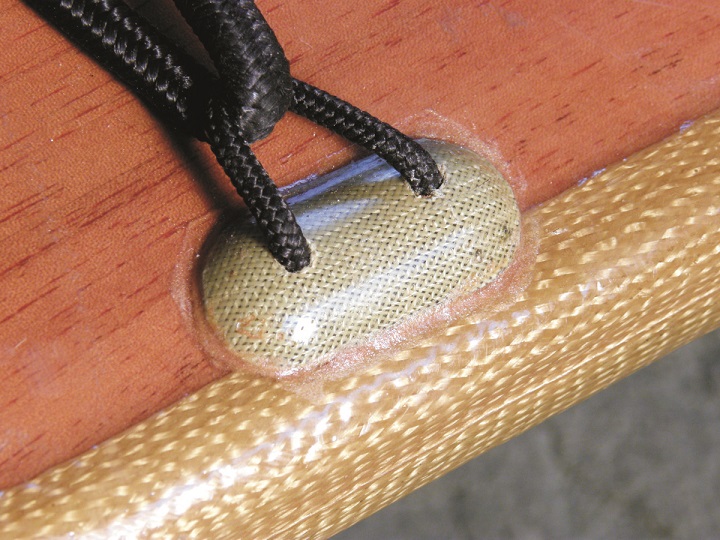
By Tom Pawlak — GBI Technical Advisor
If you look closely at some of the photos in the Bufflehead article, you will notice small eye pads (also called pad eyes) in strategic locations inside and outside of Hugh Horton’s Bufflehead. Hugh makes this lightweight carbon fiber or Twaron™ reinforced nylon line eye pads for his sailing canoes.
He glues them onto the decks or inside his sailing canoes—wherever they’re needed to hold supplies in place or hold flotation inside the hull. The eye pads are easy to make and amazingly strong.

Hugh starts with simple cup-shaped molds about 3/16″ deep by 1& 1/4″ wide by 2″ long. (He employs several molds to make the process more efficient.) In the version shown in the photos, he applies one layer of 5.8 oz carbon fiber fabric, wet out with 105 Epoxy Resin®/207 Special Clear Hardener™ into the molds and allows them to cure.
Next, Hugh releases the molded carbon fiber cups and drills two 1/8″ diameter holes about an inch apart, centered and parallel to the 2″ length. He cuts 3& 1/2″ lengths of 1/8″ nylon line and applies a couple of wraps of narrow electricians tape about 1/2″ in from each end. He feeds the lines through the drilled holes from the molded side of the cup until the tape touches the cup. He then frays the line ends in preparation for gluing. This results in something similar in appearance to a couple of cotton balls.
After wetting out the frayed nylon fibers with 105/205, he glues the line ends and fills the cups with the same epoxy thickened with 403 Microfibers. Before cure, he places them onto heavy, clear plastic film. While applying the glue, he tries to keep the frayed ends splayed out uniformly in all directions. When the cups have cured, Hugh removes them from the plastic and sands the bottom in preparation for gluing them onto his boats.
He recently experimented with making the pad eyes using our pre-thickened specialty epoxies: Six10® Thickened Epoxy Adhesive and G/flex® 655 Adhesive. The results have been excellent.
When we heard of Hugh’s experiments, we offered to test the holding power of the soft eye pads using an extraction device that incorporates a digital load cell.



For comparison purposes, we tested some injection-molded plastic eye pads that were glued down with G/flex 655 Adhesive and Six10 Adhesive. We even glued some of the soft pad eyes down with our G/5® Five-Minute Adhesive.
In the end, all the pull-off strengths fell between an impressive 526 pounds and 724 pounds. The soft eye pads Hugh makes weigh 5.3 grams each while the molded plastic pad eyes, purchased through a marine supply catalog, weighed 21.25 grams each.






